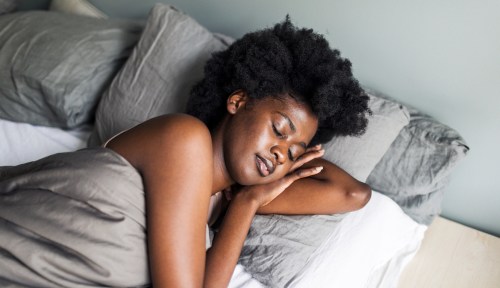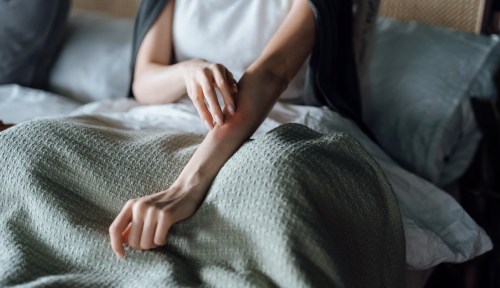My Periods Were Full of Painful Nights Until I Found This Sleeping Position That Alleviated My Cramps and Clots
Cramps and clots got you tossing and turning? Check out these sleeping positions for period cramps to help you snooze in actual comfort.

When I was a child, I remember watching my older sister sleep in a chaise lounge in our shared room. One week a month, during her period, that was her bed. She always said that lying down to sleep was more painful, and caused a mess of period blood. Her solution to those woes was to sleep upright.
Experts in This Article
board-certified OB/GYN based in Atlanta, GA
certified holistic nutritionist, menstrual health coach, and founder, The Sync Cycle Academy.
psychologist and holistic sleep specialist
When I started my cycle years later, I followed her example and spent my nights upright (and grossly uncomfortable from neck and back pain) in the same pale peach chair. One day, a group of my middle school friends talked about how their cramps felt so much better after laying down for a while, so I figured getting horizontal was worth a try. I tried lying down normally in my bed that very night, but didn’t find any relief. The waves of pain from cramps radiating out through my center were on repeat every few minutes, causing me to pop up moaning.
“Why don’t you just sit up?” my younger sister suggested, hearing my discomfort from the other room. We made a habit of checking in on each other during “that time of the month” because the cramps felt crippling. And she was right. I sat up and slowly but surely fell asleep. But I would still wake up with aches and pains in my spine from spending the night in an upright position.
Throughout my adult years, the sleep challenges have persisted well into motherhood, making it difficult to find a Goldilocks sleeping position for my period that wouldn’t make my cramps worse—or put the rest of my body in pain.
Why sleeping comfortably during your period is so challenging
There’s lots of evidence showing a link between the menstrual cycle and sleep issues. For example, the menstrual phase (aka the days when you’re actually bleeding) has been linked to changes with REM sleep patterns. People with an irregular cycle (meaning the time between periods is longer or shorter than the standard 21- to 35-day cycle) are more likely to have sleep issues1 compared to people with a regular cycle. Research also shows that if you have PMS symptoms like cramps or other pain, you’re more likely to have trouble sleeping. Plus, the contraction of uterine muscles that causes lower-belly cramps during the menstrual phase can be strong enough that the pain radiates to your thighs and lower back, potentially making sleep even more challenging.
Aside from cramps, my chief source of discomfort is clotting. “Lying down during the night increases menstrual clots for some people,” says board-certified obstetrician-gynecologist Amy Wetter, MD. Instead of gravity doing the work of letting blood exit your uterus and vagina, “menstrual blood collects in the vagina when you are lying down,” she says. This is what leads to the gush of blood I’ve long felt when standing up after a night of sleep, or during that first morning pee. (Some research also shows that people who have clots during their periods are also twice as likely to have painful periods, which likely doesn’t gel with sleeping well, either.)
Having adequate sleep is not just for comfort. It is a time when the body naturally rests and heals. Also, the hormones produced when women sleep, like cortisol and leptin, help to regulate digestion, stress responders, and immune functioning. Getting a good night’s rest also supports your mental health and mood, sharpens your concentration and memory, and many many other important functions your body needs to thrive.
Figuring out the solution for better sleep during your period may actually help with the pain, too. “Sleep and pain have a bidirectional relationship, and the current data suggests that the effects of sleep on pain are likely stronger than the effects of pain on sleep,” adds Sarah Silverman, PsyD, a psychologist and behavioral sleep medicine specialist. So, quality sleep can equal less pain, which can, in turn, make it even easier to sleep the next night.
The best sleeping positions for managing period cramps
Clearly, there are all kinds of hurdles to getting a good night’s sleep on your period. Among the many options available to support good shut-eye (such as trying magnesium supplements, mindfulness techniques, cutting out caffeine, and more), experts suggest that changing your sleep position can solve some of these issues. “If you’re sleeping in a position that is uncomfortable for you, it can contribute to your overall pain levels,” says Dr. Silverman.
This certainly was the case for me. A couple months ago, I became fed up with the aches and discomfort, so I created an array of pillows to support every angle of my back, arms, and neck. I angled one of our European pillows (the decorative ones) to support my lower back. Then I added a new backrest pillow over the European one. Behind my head, on top of the two lower pillows sat my regular sleeping pillow. This configuration ensured that I was sitting upright, but had comfortable neck and arm support to actually make sleeping upright comfortable. My arms lay atop the armrests of the backrest pillow, and it felt like a cloud.
In this one night, I shed years of discomfort, finally attaining restful sleep while on my cycle.
My perfect position may not be ideal for everyone. Below, find a few that experts recommend to relieve pain and help you get a good night’s sleep while on your period.
Child’s pose
Nicole Bendayan, a certified holistic nutritionist who specializes in menstrual health, recommends this position she and her clients use to relieve back pain. Take a face-down position, tuck, and spread your knees beneath you with your belly lowered between them. Then reach your arms forward. You can grab your pillow and get comfy with your upper body.
Fetal position
Dr. Wetter recommends this position if you have cramps, saying it “may help because you are relaxing your abdominal muscles in this position.” Simply lie on your side with your legs curled up into a ball.
Pillow positioning
Lower back pain is common during the menstrual phase due to hormonal changes and uterine contractions. Use pillows to help provide extra support while you sleep by placing one between your knees while sleeping on your side, in order to alleviate lower back pain. (If you’re a back sleeper, put a pillow under your lower legs instead; this also helps with hip pain.)
Jeon, Bomin, and Jihyun Baek. “Menstrual disturbances and its association with sleep disturbances: a systematic review.” BMC women’s health vol. 23,1 470. 1 Sep. 2023, doi:10.1186/s12905-023-02629-0
↩︎
Sign Up for Our Daily Newsletter
Get all the latest in wellness, trends, food, fitness, beauty, and more delivered right to your inbox.
Got it, you've been added to our email list.










